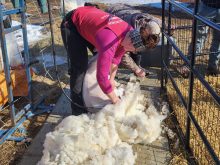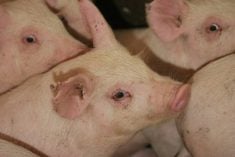Composted manure has been accepted as a good soil additive and research is showing it could control greenhouse gas emissions.
A project at Olds College added perlite and zeolite to cattle manure in a composting program to reduce the release of nitrous oxide and methane while retaining valuable
nutrients.
The project is funded through a five year $30 million federal greenhouse gas mitigation program. It examined various compost mixtures with the final test assessing the effects on grazing and cropland.
This project is among many across the country administered by the Canadian Cattlemen’s Association as part of its effort to reduce greenhouse gases in the atmosphere. The dairy and pork industries as well as the Soil Conservation Council of Canada have similar programs to reduce agricultural emissions.
Read Also

Charges laid after cattle theft
Saskatchewan RCMP lay two charges against a man after six cattle went missing.
Programs demonstrate management practices that could improve feed efficiency and provide positive environmental benefits through improved grazing or cropping systems.
“They’re practical, sensible management practices. They either sequester carbon or show us a decrease in actual greenhouse gas emissions of some variety,” said Peggy Strankman, environmental co-ordinator for the cattlemen’s
association.
This is the last year of the greenhouse gas program and it has been difficult to get the information to farmers and convince them to try new ideas after living through more than two years of the effects of BSE.
“It has been a challenge reaching producers over the last two years. Obviously, greenhouse gases hasn’t been our top priority,” Strankman said.
The Olds College project has several years of data to show crop benefits using different mixtures of perlite and zeolite as an amendment to compost made from feedlot manure. Perlite helps aerate the soil and zeolite acts as a slow release fertilizer.
It found levels of the perlite at 17 percent resulted in lower composting temperatures, while five percent mixes appeared to stimulate composting temperatures. Temperature is an indicator of biological activity in the mix and heat is necessary to destroy harmful bacteria and other pathogens.
Researchers looked at ways to ensure greenhouse gases like methane were not released as the compost cured. If it is turned regularly in the windrow, more oxygen gets into the mix and prevents odours from the release of gases.
“Oxygen is toxic to the bacteria responsible for producing methane,” said college researcher Abimbola Abiola.
The compost was applied to crop trials according to the amount of nitrogen found in the mix. It performed as well as commercial fertilizer when applied at the correct levels.
Forage crops receiving compost were lusher with better root systems.
For the fields around the college, four to six tonnes of compost per acre were required to achieve the full nitrogen benefit. Some compost was incorporated into the soil while a manure spreader was used on other fields. Benefits spread over several years because nutrients are released slowly.
For comparison, commercial nitrogen fertilizer was applied at a rate of 60 pounds per acre. Other areas have done similar projects with favourable results.
Environment Canada has determined the agriculture sector is responsible for about 10 percent of total greenhouse gas emissions.
The main culprits are carbon dioxide, nitrous oxide and methane. Carbon dioxide is released by most industries while methane comes from manure and livestock digestion. Nitrous oxide occurs during manure handling and use of commercial fertilizer. Beef and dairy cattle produce methane as part of the normal digestive process. Most of the gas is released through burping and ordinary breathing. The more methane an animal releases, the more energy it is losing.
Between two and 12 percent of total feed energy consumed by cattle can be lost as methane gas. High quality forage can reduce methane by as much as 20 percent.

















